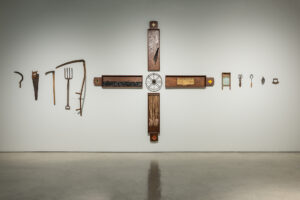According to curator Ralph Rugoff, the 55 tiny works by 27 artists in this exhibition, which included a wide range of media and aesthetic concerns, “set up certain shared formal and psychological relationships… Minute artworks involve us, sometimes quite literally, in acts of discovery.” He goes on to say, “Tiny artworks force us to draw closer in order to scrutinize theme, and this forward movement parallels a mental process: the more closely we examine minute details, the less we notice the gulf in size that separates us.”
While there is a long tradition of miniaturization that perhaps culminates in the rise of nanotechnology, through much of this century the large size of many artworks has been associated with notions of heroic, the sublime and the spectacular. In this exhibition we see how these qualities can be achieved even through the smallest amount of material if we are prepared to suspend conventional expectations and beliefs.
The artists represented are from a large number of national origins: American, British, Canadian, Egyptian, French and Japanese. Among them are Hannah Wilke, who might be remembered in Windsor because of the nude performance piece she presented at the AGW in 1985, Chris Burden, Gene Davis, Elizabeth LeMoine, Yoko Ono, Joel Sharpiro and Richard Tuttle.
Reviewing the exhibition for the Globe an Mail, Murray Campbell wrote: “Standing back to look at a Jackson Pollock canvas that dominates a huge room is like talking to someone across an enormous desk. Getting close enough to minuscule artwork to be able to see it is like whispering in someone’s ear. You become intimate.”





